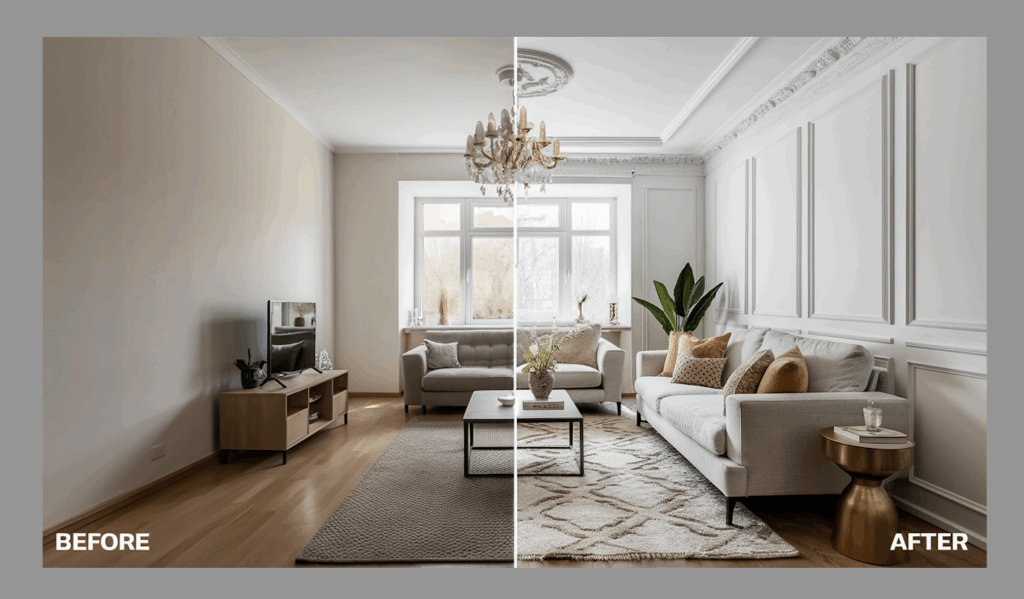Crown molding can reshape your space using before-and-after photos. You’ll notice how it affects the atmosphere of a room, adding personality and flair.
I’ll also share tips on selecting the right molding and deciding whetherit’s a project you can take on yourself or one better left to a professional.
If you’ve been thinking about adding crown molding but don’t know where to begin, I’m here to guide you. Here, you’llfind actionable ideas to improve your space and bring your design vision to life.
What Is Crown Molding?

Crown molding is a type of trim that runs along the top edge of a wall, where it meets the ceiling. Its main job is to add a decorative touch, making the space feel more polished and finished.
Traditionally, it’s been used in homes to create an elegant transition between the wall and ceiling.
There are many styles of crown molding. Some are simple and clean, while others are more intricate with curves and patterns.
You can choose from modern, traditional, or vintage styles. Each style brings its unique flair to a room.
You have options when it comes to materials. Wood, MDF (Medium Density Fiberboard), and polyurethaneare common choices.
Wood is classic and durable, but MDF is more budget-friendly and easy to work with. Polyurethane is lightweight and great for a smooth finish.
Crown molding is versatile. It works in almost any room—from living rooms to kitchens, and even bathrooms. It can complement any design, whether you’re going for a modern, rustic, or cozyvibe.
Before & After: Real-Life Room Transformations
Living Room Revamp
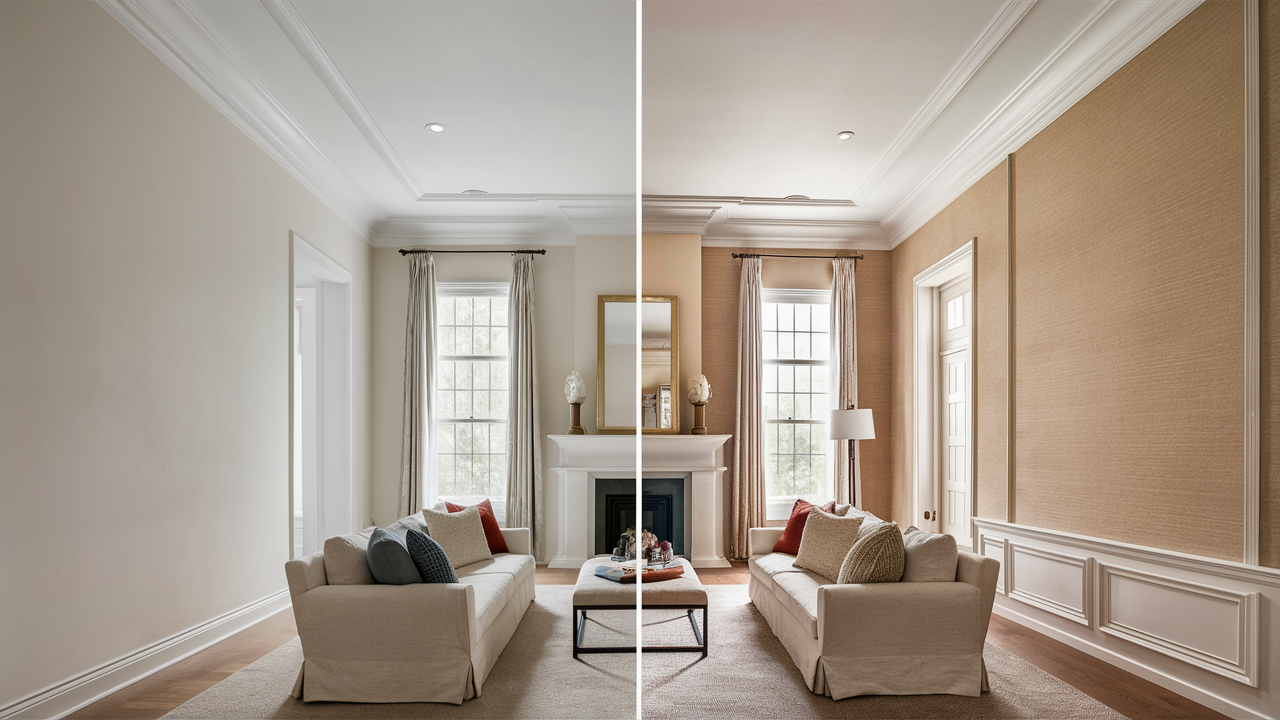
I started with myliving room. Before crown molding, the room felt a bit plain, like it was missing something. After the molding was installed, the space instantly felt taller and more refined.
The once-simple walls now have added detail, and the entire room appears more cohesive. It’s impressive how such a small addition can influence the atmosphere of the space.
Bedroom Makeover
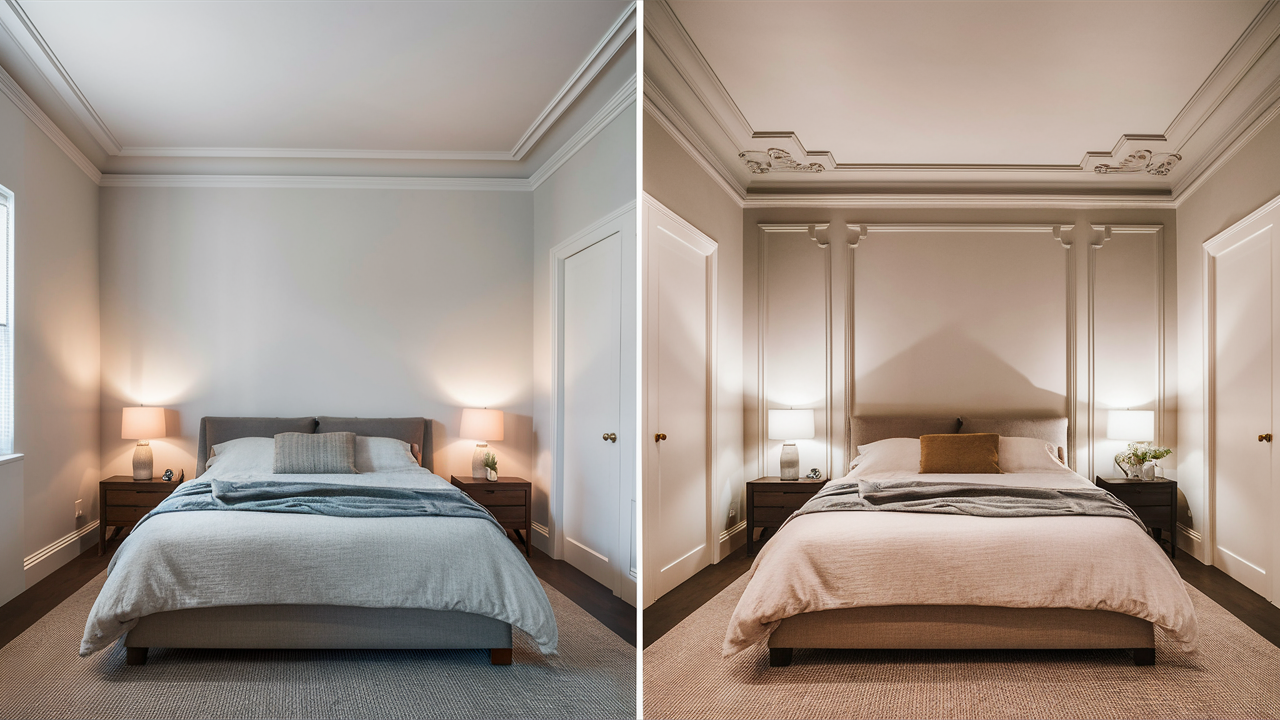
The bedroom was nice, but it didn’t really stand out. Adding crown molding around the ceiling made it feel more finished and put together.
The space now looks intentional, as if it has been purposefully designed. It connects the walls and ceiling in a way that feels fluid and harmonious.
Kitchen Enhancement
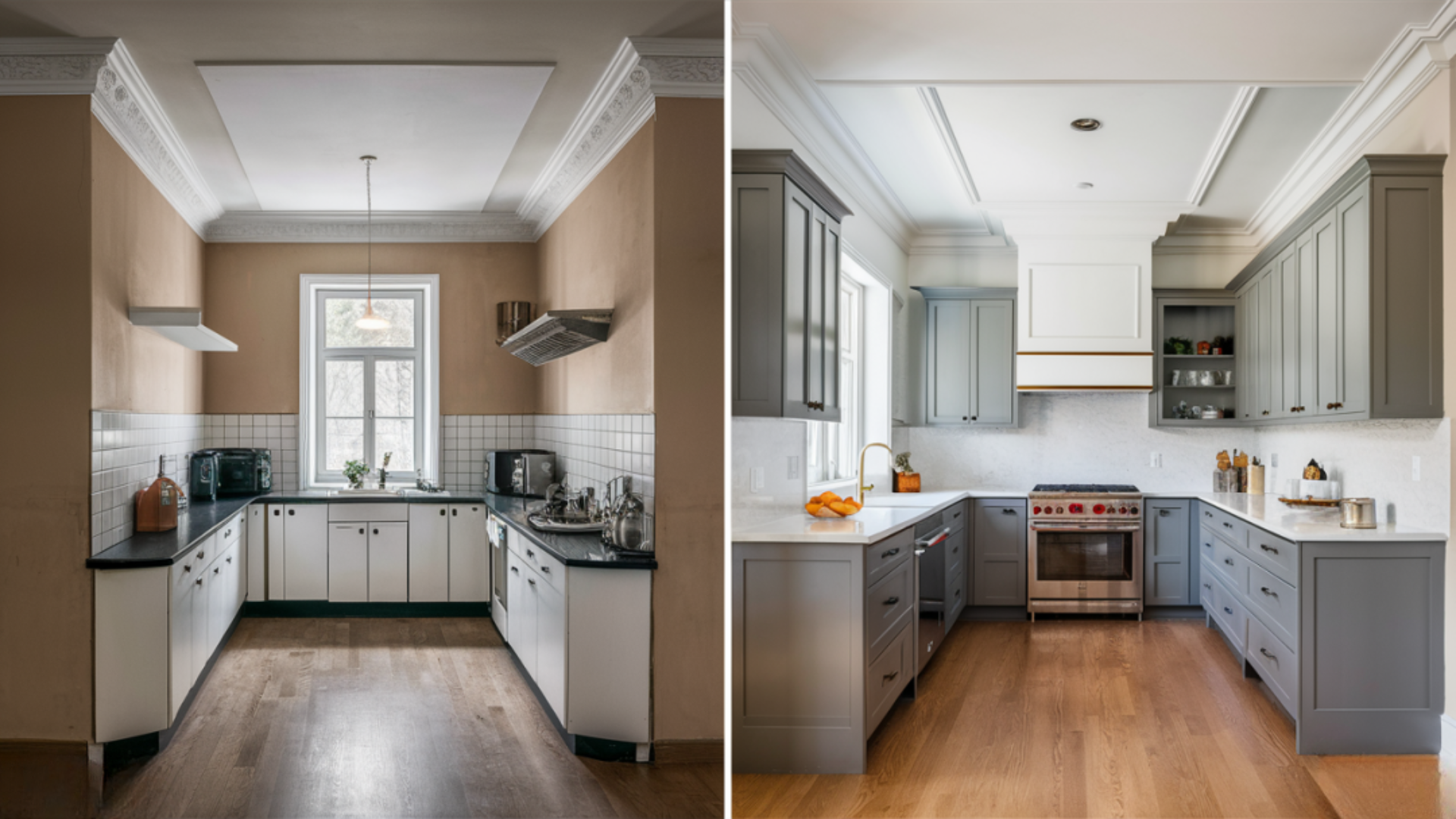
The kitchen felt a bit disconnected before. Adding crown molding helped bring everything together and made the space feel more complete.
The molding introduced a sense of structure that brought the cabinets, walls, and ceiling into one well-balanced design. It’s thoughtful touches like this that make your kitchen feel more inviting and complete.
| Room Type | Before Crown Molding | After Crown Molding |
|---|---|---|
| Living Room | Plain, lacked detail, walls felt disconnected. | Feels taller, more refined, and visually unified. |
| Bedroom | Pleasant but lacked a complete finish. | Looks thoughtfully put together with a smooth flow. |
| Kitchen | Disconnected design, elements felt separate. | Unified look that connects cabinets, walls, and ceiling. |
Choosing the Right Crown Molding for Your Space
Style Considerations
When choosing crown molding, think about the style of your room. Is it modern, traditional, or rustic? The right molding should blend in with your existing decor.
For contemporary spaces, you might want something simple and clean. For traditional rooms, go for something more detailed. If you have a rustic style, look for molding with a bit more texture.
Material Selection
Next, let’s talk materials. You’ll usually choose between wood, MDF, and polyurethane. Wood is strong and timeless, but it can be pricey. MDF is a good option if you’re on a budget; it’s durable and easy to work with.
Polyurethane is lightweight and available in manystyles, making it a solid choice if you want something easy to install and maintain.
Size and Proportion
The size of your molding is important. Too large, and it might overwhelm the room. Too small, and it won’t make the impact you want. Measure your room carefully.
A smaller room benefits from more subtlemolding, while a larger room can handle bolderstyles. Choose a size that feels balanced with the space.
DIY vs. Professional Installation
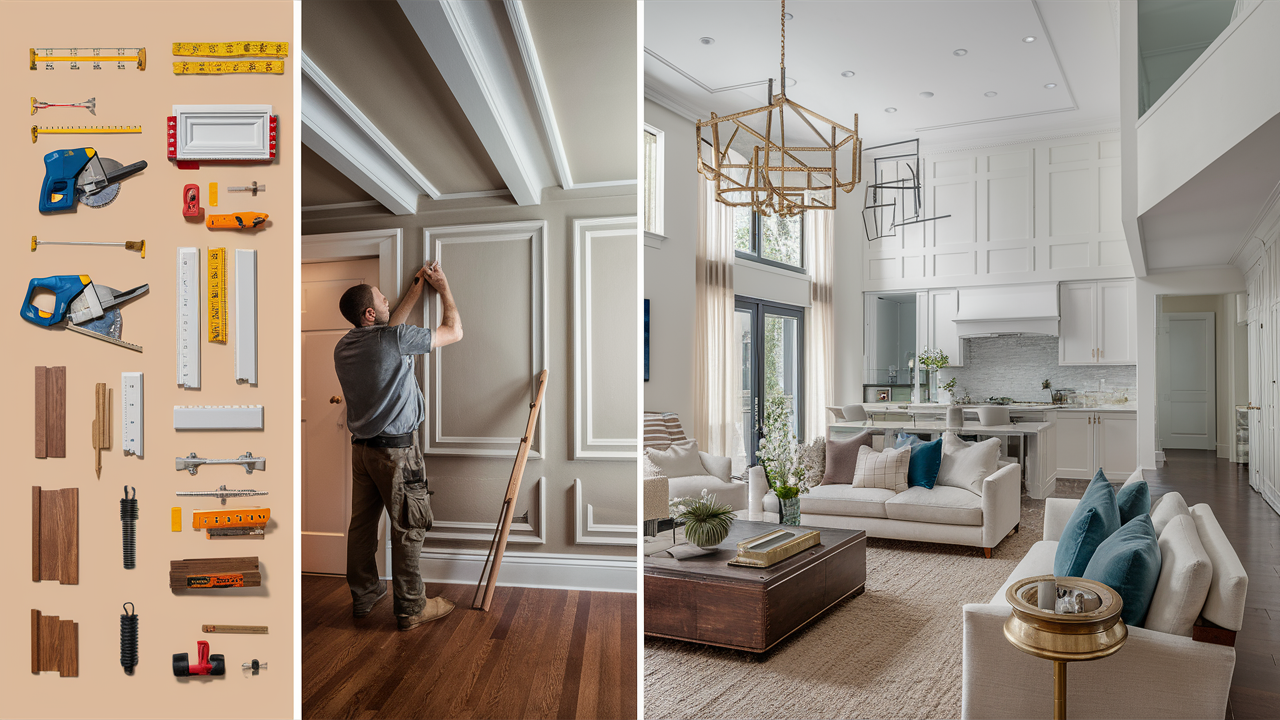
DIY Installation
If you’re feeling handy, installing crown molding yourself can be a fun project. Here’s a simple guide to help you get started:
-
Gather Your Tools: You’ll need a miter saw, measuring tape, nails, a hammer, and adhesive.
-
Measure Your Space: Measure the length of the walls where you’ll install the molding, taking into accountcorners.
-
Cut the Molding: Use the miter saw to cut the molding pieces to the correct lengths. Make sure the angles are correct, especially for corners.
-
Dry Fit the Molding: Before nailing anything, dry fit the molding along the wall to ensure it fits perfectly.
-
Install the Molding: Apply adhesive to the back of the molding, then press it into place. Nail it into the wall for a secure fit.
-
Fill Gaps: Use caulk to fill any gaps or seams where the molding meets the wall or ceiling. If desired, finish with a coat of paint.
It’s doable, but it can be tricky, especially if you’ve never done it before.
Professional Help
If you’re unsure about cutting angles or working with tricky corners, you might want to consider hiring a professional. Complex designs, high ceilings, or large spaces can make the job more difficult.
Professionals have the tools and experience to get the job done right without mistakes. They can also work faster and handle any issues that might pop up during installation.
If you want a flawlessfinish without the hassle, a professional might be the way to go. It’s a bit more expensive, but the results will be worth it.
Budget-Friendly Tips
- Cost-Effective Materials: For an affordable yet high-end look, use MDF or polyurethane. These materials are easy to install and durable.
- DIY Hacks: Try peel-and-stick moldingsfor a quick, budget-friendly upgrade. They’re perfect for renters or temporary solutions.
- Phased Installation: Install in phases to spread out costs and avoid a large upfront expense. Focus on one room at a time for a manageable budget.
Conclusion
Crown molding is a straightforward yet impactful way to update any room. It improves the overall look by adding definition and visual interest, helping your space feel more complete and intentional.
Whether you’re updating a single room or working on a larger renovation, crown molding offers a subtle yet noticeable upgrade. It can enhance not only the style of your home but also its potential value.
If you’re planning changes to your space, crown molding is a smart detail to consider. Reviewvarious styles, materials, and installation methods to find the right fit for your home.
See the rest of our website for more practical tips and design ideas. We’re here to help you make your home more comfortable and appealing.

